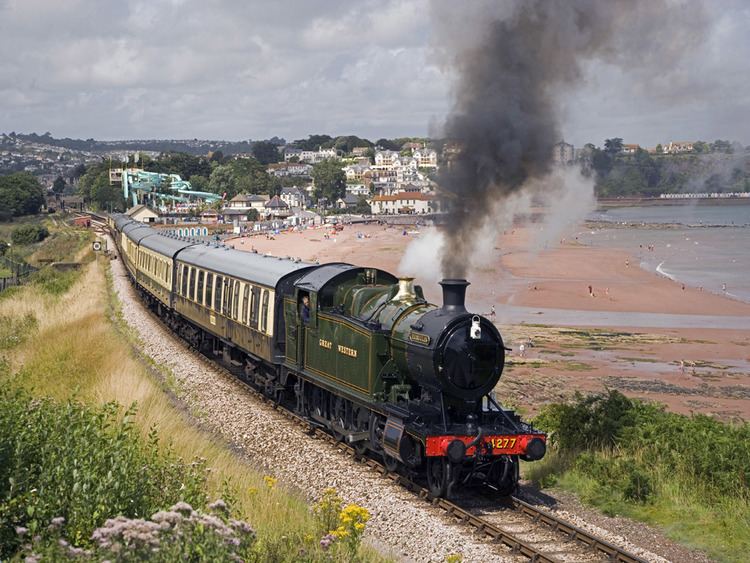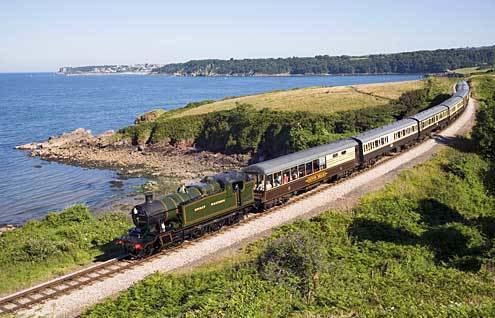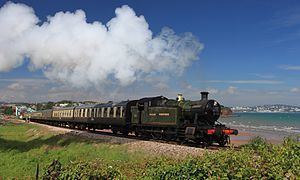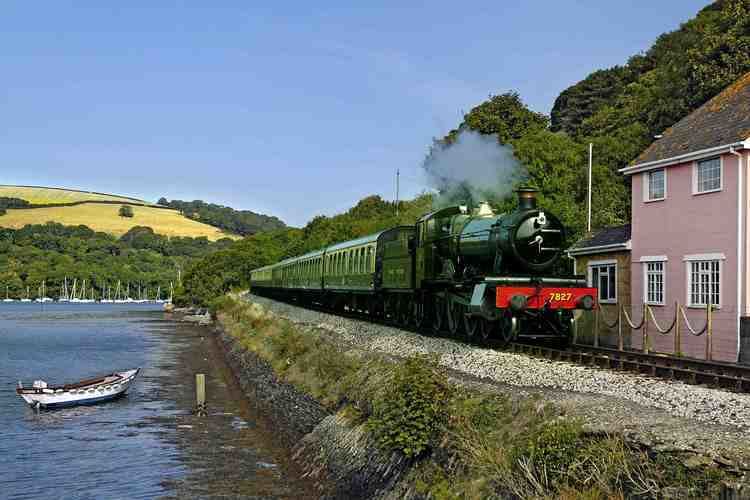Stations 5 Opened 1859 | Length 10,783 m Termini Kingswear | |
 | ||
Original gauge 7 ft ⁄4 in (2,140 mm) Brunel gaugeuntil 1892 Operated by Dart Valley Railway PLC Preserved gauge 4 ft 8 ⁄2 in (1,435 mm) standard gauge Similar Goodrington Sands railway st, River Dart, Kingswear railway station, Splashdown Quaywest Waterpark, Paignton railway station | ||
The dartmouth steam railway
The Dartmouth Steam Railway, formerly known as the Paignton and Dartmouth Steam Railway, is a 6.7-mile (10.8 km) heritage railway on the former Great Western Railway branch line between Paignton and Kingswear in Devon, England. Much of the railway's business is summer tourists from the resorts of Torbay who are transported to Kingswear from where the Dartmouth Passenger Ferry takes them across the River Dart to Dartmouth.
Contents
- The dartmouth steam railway
- Double manors dartmouth steam railway 17th 19th july 2015
- Kingswear branch
- Heritage railway
- Ownership
- Operation
- Route
- Visiting locomotives
- Coaches
- Freight
- References

The line is owned and operated by Dart Valley Railway plc. This also owns Dart Pleasure Craft Limited which operates the Dartmouth Passenger Ferry as well as river and coastal cruises. The railway and connecting boat and bus services are jointly promoted as the Dartmouth Steam Railway and River Boat Company.

It is unusual amongst heritage railways in that it is a commercial operation so does not rely on volunteer labour or charitable donations, although a few volunteers help at Churston railway station.

Double manors dartmouth steam railway 17th 19th july 2015
Kingswear branch

The line was built by the Dartmouth and Torbay Railway, opening to Brixham Road station on 14 March 1861 and on to Kingswear on 10 August 1864. The Dartmouth and Torbay Railway was always operated by the South Devon Railway and was amalgamated with it on 1 January 1872. This was only short-lived as the South Devon Railway was in turn amalgamated into the Great Western Railway on 1 February 1876. Brixham Road became a junction and was renamed "Churston" on 1 January 1868 when the independent Torbay and Brixham Railway opened its short line.

The line was single-track except for a crossing loop at Churston. It had been built using the 7 ft (2,134 mm) broad gauge, but on 21 May 1892 was converted to 4 ft 8 1⁄2 in (1,435 mm) standard gauge.

West of Greenway Tunnel the railway was originally carried across two creeks on low timber viaducts, that at Longwood being 200 yards (183 m) long and Noss being 170 yards (155 m). These were demolished after the line was moved inland around the creeks on 20 May 1923.
A station was opened at Goodrington Sands, south of Paignton, on 9 July 1928. A second new halt was constructed at Broadsands Halt at the same time but was never opened for timetabled trains. Park Sidings opened alongside Paignton Station in 1930 to give more room to stable carriages. A goods depot opened south of the station the following year, and the running line was doubled as far as Goodrington Sands.
The Great Western Railway was nationalised into British Railways on 1 January 1948. Further carriage sidings to handle the heavy traffic on summer Saturdays were opened at Goodrington in 1956 and a turntable installed there in the following year.
Except for peak season trains, most services from 18 April 1966 operated as a shuttle service from Paignton; Sunday trains were withdrawn from 24 September 1967, although some were run during the summer of the following year. The Brixham branch closed on 13 May 1963 and the crossing loop at Churston was closed on 20 October 1968.
Heritage railway
In 1968 it was formally proposed to the Ministry of Transport that the line from Paignton should be closed entirely but instead, on 30 December 1972, the line was sold to the Dart Valley Railway Company Ltd, which at that time operated the nearby heritage railway that subsequently became the South Devon Railway. A winter service was operated from 1 January 1973 but from the end of that summer it became a purely seasonal operation. The purchase price of the railway was £250,000 and a further £25,000 was paid for signalling alterations at Paignton. Most of this was recouped from the sale of The Royal Dart Hotel at Kingswear and other surplus land.
An independent station alongside the main station at Paignton, known as "Queens Park", was opened to serve the Kingswear trains on the site of the old Park Sidings. The line was initially marketed at the time as the "Torbay Steam Railway", but this has since been changed to the "Dartmouth Steam Railway". It remains the property of The Dart Valley Light Railway Company plc.
A loop was reinstated at Churston in 1979 using colour-light signals, and in 1981 the turntable from the British Rail sidings at Goodrington was moved there, to the north of the station aligned on the old Brixham branch. In 1991 the control of all signalling was moved to a new panel at Britannia Crossing near Kingswear. A locomotive workshop was opened at Churston in 1993 and a carriage shop opened there three years later.
In 2007 the passing loop at Goodrington Sands was reinstated, along with the carriage sidings to give more space for storing rolling stock. In 2011 new offices for the railway and boats were opened at Kingswear in the style of a large GWR-style signal box. The following year saw the Dartmouth Steam Railway's station at Paignton rebuilt in GWR style, and a new unstaffed station opened at Greenway Halt to serve Agatha Christie's Greenway Estate.
Ownership
The Dart Valley Railway Company Ltd was formed initially to purchase the trackbed and station sites of the Totnes to Ashburton line, which is now known as the South Devon Railway. On 30 December 1972, the Paignton to Dartmouth line was also sold to the Dart Valley Railway Company Ltd by the Ministry of Transport.
In 2010, the South Devon Railway Trust bought the freehold of the Totnes to Ashburton line from what was the Dart Valley Railway plc, on 8 February 2010. Until 2016, a Channel Islands based businessman was the major shareholder in the plc company, until he sold his entire one third share holding to businessman and steam railway enthusiast, Jeremy Hosking.
Operation
The operational base is at Paignton, where an engine shed is part of the station buildings. Heavy overhauls are undertaken at Churston where there is a locomotive workshop on the west side of the line, and a carriage shop and turntable on the east side.
Signalling is by electric multiple-aspect signals controlled from a panel at Britannia Crossing. The level crossing at that site is supervised by the signalman at the panel, but that at Sands Road, just outside Paignton station, is operated locally by the train crew.
All stations have booking offices but those at Goodrington Sands and Churston are only open at busy times and tickets are issued on the train most of the time.
The steam railway also operates the No.100 bus service between Paignton and Totnes, some of the buses are open-top and used regularly in the Summer, this offers a connection with the railway and boat services on the river Dart and out to sea. This also includes the Paddle Steamer Kingswear Castle which operates on the river Dart in conjunction with the steam railway along with the rest of the company's river boats and ferries.
The railway run steam trains every day of their main operating season which is normally between April and November with additional low season running in February, March and November. There are also santa trains in December.
Route
The route is described facing forwards from Paignton to Kingswear, which puts the sea on the left and the River Dart on the right.
The line is 6 miles and 57 chains long (10.8 km) starts from its own platform at Paignton (also known as Paignton Queens Park). The shed for operational locomotives is built into the south end of the station building, although coaling is done at the north end alongside the entrance used by passengers. Immediately beyond the station the line crosses Sands Road on a level crossing. The second track, on the right, is used by Great Western Railway (train operating company) to access their carriage sidings. There is a crossover between the two lines that allows trains from Network Rail infrastructure to run through onto the steam railway. This is normally used by mainline railtours which run on the steam railway to Kingswear. Opposite the Network Rail carriage sidings on the right is a siding used by the steam railway to store engineering equipment. The train now calls at Goodrington Sands Halt, behind the platform to the right are more sidings which were transferred to the steam railway in 2007. There are two platforms at Goodrington Sands, which can also act as a cross over.
Beyond the Halt the line starts its climb up a steep gradient (initially 1 in 71, easing slightly to 1 in 93 and then rising to 1 in 60 before levelling out just before Churston) behind the beach huts that line Goodrington Beach. The 630 miles (1,014 km) South West Coast Path follows alongside the line on the right. After a small headland the train passes the secluded Saltern Cove and Armchair Rock, then swings right to pass over first the 72 yards (66 m) Broadsands Viaduct and then swings inland over the 148 yards (135 m) Hookhills Viaduct before reaching the line's summit at Churston. On the approach to the station the turntable is seen on the left; this is where the Brixham branch line used to join the Kingswear branch.
From here the line drops down passing Greenway Halt on the right hand side, immediately after the Halt the train will pass through the 495-yard long Greenway Tunnel beyond which the River Dart appears on the right after passing over Greenway Viaduct. Once down to nearly river level it passes over Britannia Crossing, a level crossing over the A379 road as it approaches the Dartmouth Higher Ferry. It is from the signal box here that the signalling for the whole line is controlled. Shortly after Britannia Crossing, the line arrives at Kingswear station. The far end of the platform is covered by a wooden train shed in the style favoured by Isambard Kingdom Brunel, although he died more than four years before the station was built. The boat- and car-park alongside the station was once a busy rail-served quayside goods yard.
The ferry across the Dart to Dartmouth leaves from the slipway which is behind the hotel next to the station. Dartmouth railway station is unique in that it has never seen a train as passengers have always arrived at the station by means of the ferry from Kingswear.
Visiting locomotives
Other locomotives visit the railway, either to supplement the railway's own fleet or to bring in special trains from the national rail network. However, the most frequent source of visiting locomotives is the Torbay Express, which runs from Bristol Temple Meads on selected Sundays from June through to September, and other one-off railtours which run to Kingswear. Locomotives that have made a visit to Kingswear include 5029 Nunney Castle, 5051 Earl Bathurst, 6024 King Edward I, 7802 Bradley Manor, 34046 Braunton, 46100 Royal Scot, 60007 Sir Nigel Gresley, 60019 Bittern, 60163 Tornado, 70000 Britannia and 71000 Duke of Gloucester.
Coaches
The railway has a fleet of 20 coaches with 19 available for service and a further coach has been refurbished to become a Brunel exhibit at Kingswear Station.
Eleven of the coach fleet are British Railways Mark 1 corridor coaches, 8 TSOs, 2 BSKs and a BSO. The livery of the carriages is a version of the former GWR "chocolate and cream" livery and most carry the name of either a female member of staff, or the name of a member of staff's child or grandchild. The brake carriages have had their former luggage vans converted to wheelchair accommodation.
A Pullman observation saloon, originally built for the Devon Belle service (No.13), is used regularly on passenger services. It provides a unique view of the railway, although an additional charge is made to ride in it. It was refurbished in 2012 and put back into original Pullman livery.
The rest of the coaches are former British Rail DMU class 116 and 117 trailer cars with open saloons. Seven of these are used on the trains. The eighth DMU trailer is fitted out as an exhibition coach at Kingswear telling the story of the line, its building by Isambard Kingdom Brunel, and a brief history of the local area.
Freight
The railway runs a selection of freight wagons. Although not used on any service train, they do sometimes get used for special events. Some of the wagons are used to help keep the railway in working order on engineering trains. Others are more for show and stored in sidings along the line.
